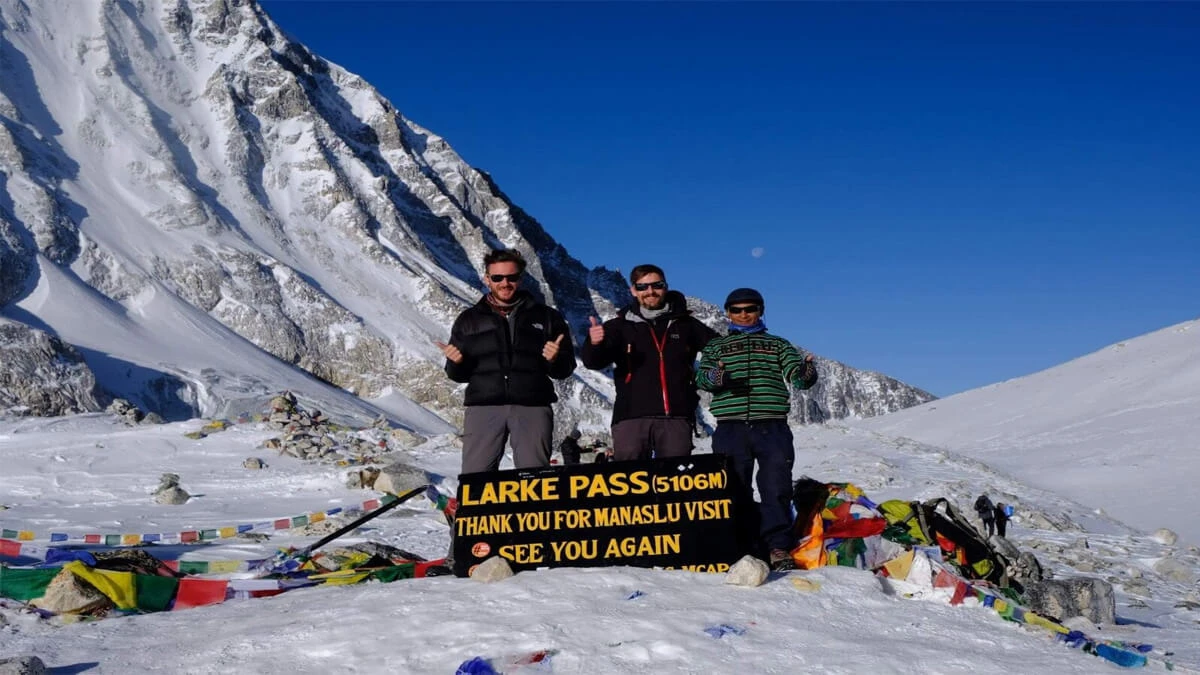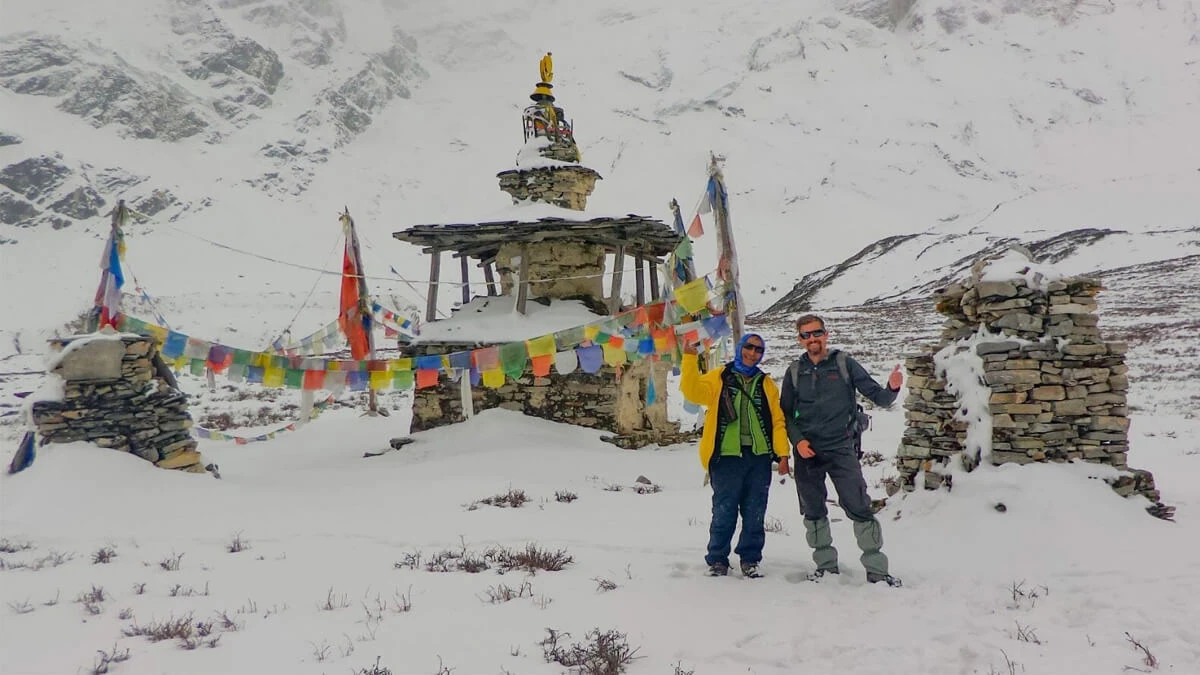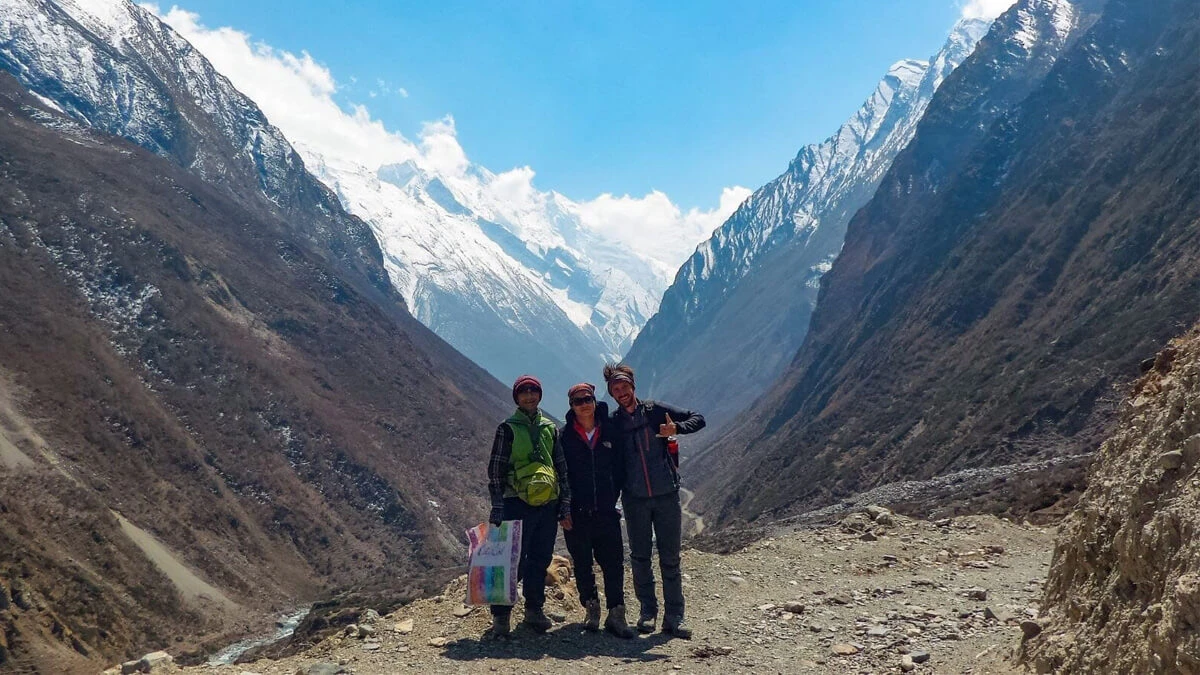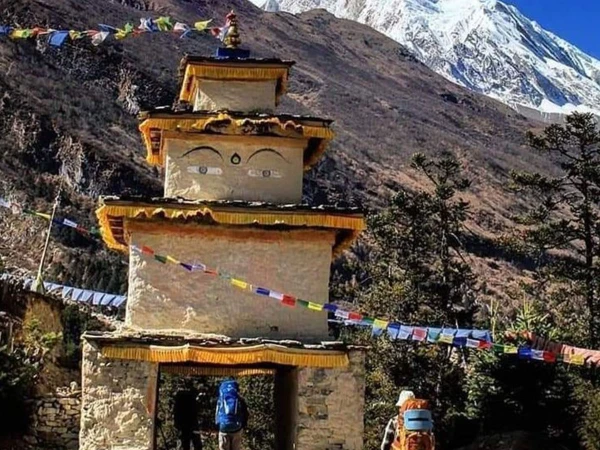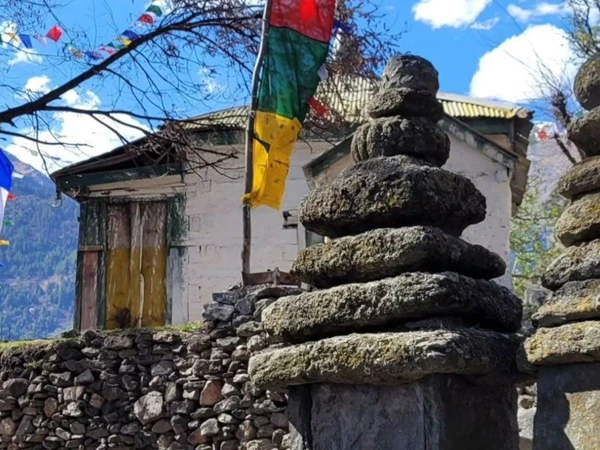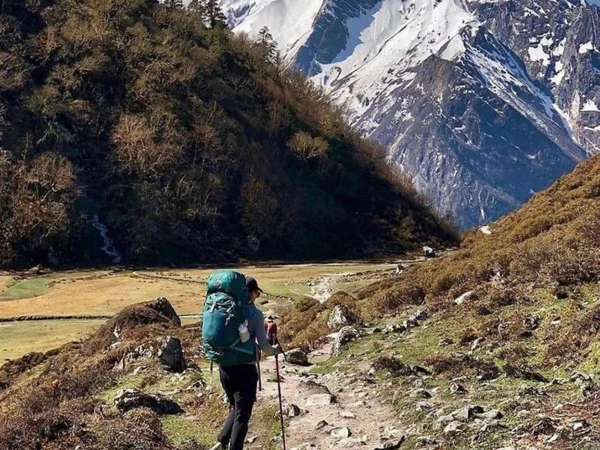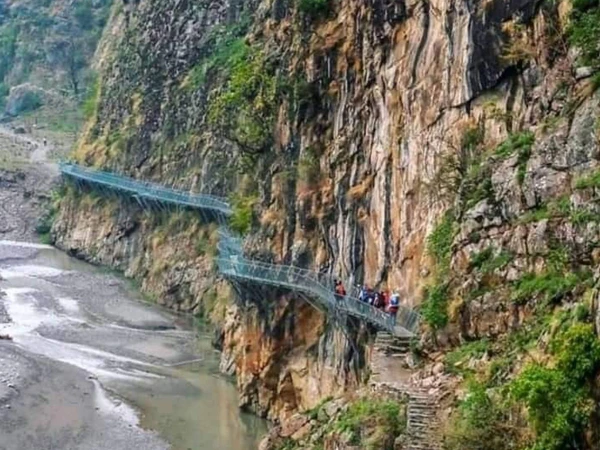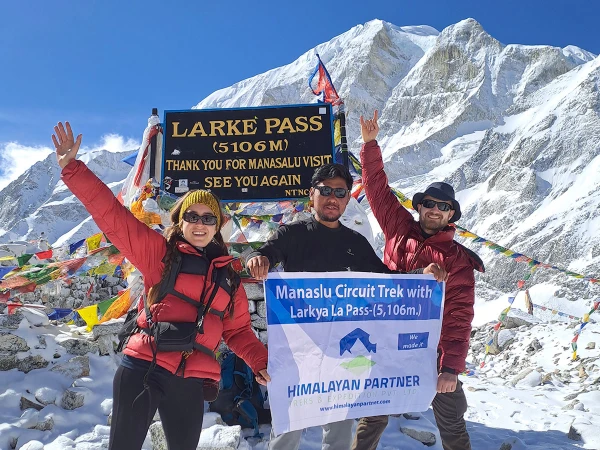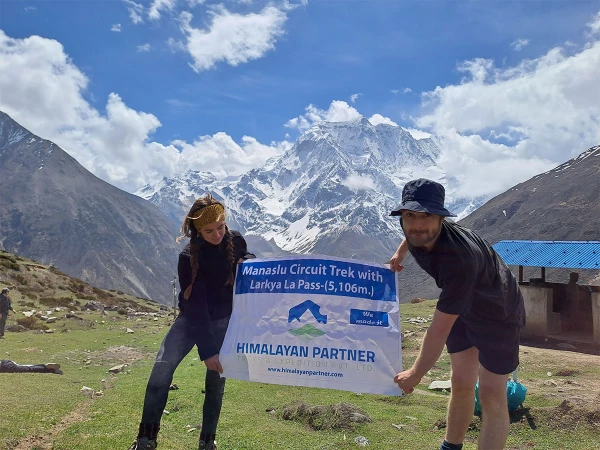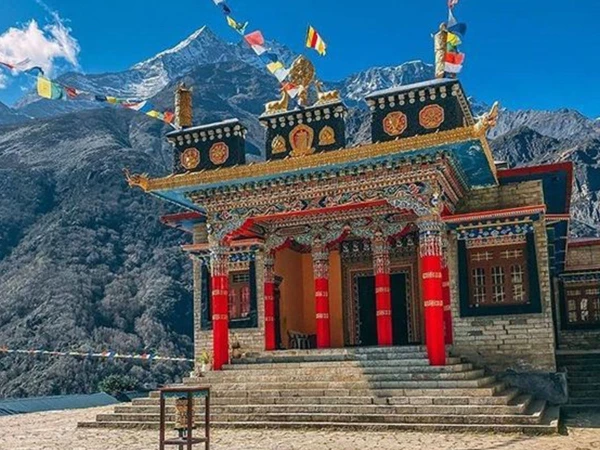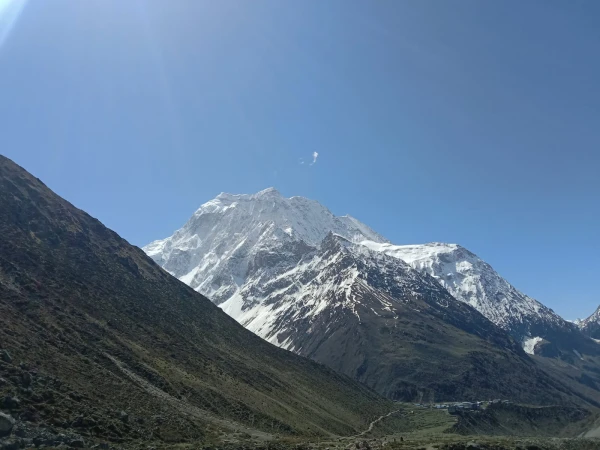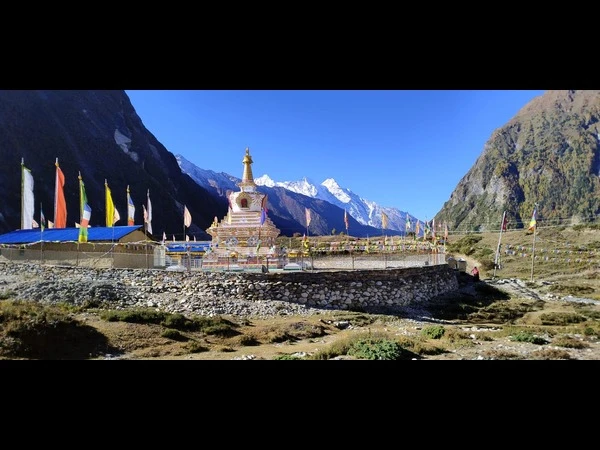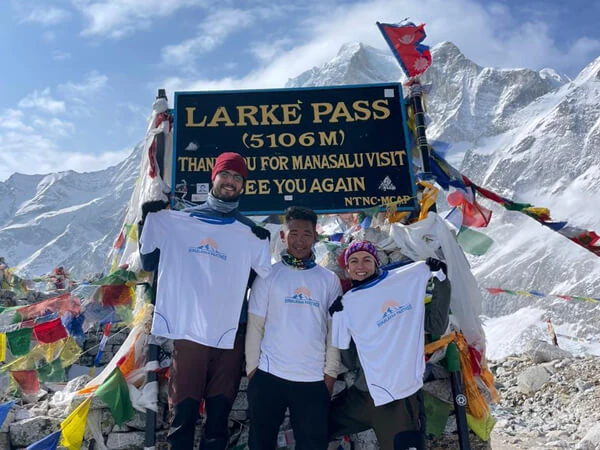What to Pack for Manaslu Circuit Trek: Essential Gear & Clothing for Every Season
What to pack for Manaslu Circuit Trek is a critical consideration for your comfort and safety. The diverse climate zones along the Manaslu trek demand a strategic layering system to adapt from subtropical warmth to freezing alpine conditions. Your Manaslu Trek Gear should be lightweight, durable, and highly functional.
Essential Clothing Layers for Your Manaslu Circuit Trek
- Base Layers (Moisture-Wicking):
- Dress: 2-3 pairs of lightweight, long-sleeved thermal tops (Merino wool or synthetic). These are worn directly against your skin to wick away sweat, keeping you dry and preventing chills.
- Dress: 2-3 pairs of thermal bottoms (Merino wool or synthetic). Essential for warmth during cold nights and for adding an extra layer of insulation on high-altitude trekking days.
- Mid Layers (Insulation):
- Dress: 2-3 fleece jackets or lightweight down jackets. These layers provide crucial warmth and insulation over your base layer. A medium-weight fleece for milder days and a heavier fleece or light synthetic fill jacket for colder conditions are recommended.
- Dress: 1-2 pairs of comfortable trekking trousers (quick-drying, durable fabric like nylon or synthetic). Convertible pants (that zip off into shorts) can be versatile for lower altitudes.
- Outer Layers (Shell Protection):
- Dress: 1 waterproof and windproof jacket (Gore-Tex or similar material, with sealed seams). This is your primary defense against rain, snow, and strong winds, vital for unpredictable mountain weather, especially around the Larkya La Pass.
- Dress: 1 pair of waterproof and windproof trekking pants. Essential for wet weather, crossing streams, and snow-covered sections.
- Dress: 1 high-quality down jacket (rated for -10°C to -20°C / 14°F to -4°F). This heavy-duty dress is indispensable for extreme cold, particularly during evenings, early mornings, and at higher camps near the pass.
- Headwear:
- 1 warm woolen or fleece hat/beanie: Provides essential warmth for your head in cold conditions.
- 1 wide-brimmed sun hat or cap: Offers sun protection for your face and neck at all altitudes.
- 1-2 buffs or neck gaiters: Versatile for neck warmth, sun protection, or as a face mask in dusty or windy conditions.
- Handwear:
- 1 pair of thin liner gloves (fleece or synthetic): For dexterity and light warmth.
- 1 pair of warm, waterproof, and windproof outer gloves or mittens: Critical for freezing temperatures, especially when crossing the high pass.
- Undergarments:
- 5-7 pairs of moisture-wicking underwear (synthetic or Merino wool).
- 2-3 sports bras for women (moisture-wicking).
- Socks:
- 3-4 pairs of thick wool or synthetic hiking socks: Moisture-wicking to prevent blisters and provide cushioning.
- 2-3 pairs of thin liner socks (optional): Worn under thicker socks to reduce friction.
- 1-2 pairs of warm thermal socks: For sleeping or very cold evenings in teahouses.
Footwear for Your Manaslu Circuit Trek
- Trekking Boots: 1 pair of sturdy, waterproof, and well-broken-in hiking boots with excellent ankle support. This is the single most critical item for your feet on the Manaslu trek. Ensure they are comfortable and tested on practice hikes.
- Camp Shoes/Sandals: 1 pair of lightweight sandals, Crocs, or comfortable camp shoes for use in teahouses and around villages to allow your feet to air out and rest.
- Gaiters: (Optional but highly recommended, especially for monsoon, late spring, or winter treks) to keep snow, mud, and debris out of your boots.
- Microspikes: (For winter or icy conditions) If you are undertaking the trek Manaslu in colder months or early spring, these provide essential traction on icy sections of the trail, particularly near Larkya La Pass.
Essential Trekking Gear & Equipment for Manaslu Circuit Trek
- Backpack (50-70 liters): Your main trekking backpack to carry your personal gear that will be carried by a porter (maximum 15-20 kg limit).
- Daypack (25-35 liters): A smaller backpack for your daily essentials (water, snacks, camera, extra layers, personal first-aid kit, valuables).
- Sleeping Bag: A high-quality down sleeping bag rated for at least -10°C to -20°C (0°F to 10°F) is essential for warmth in teahouses, which often lack heating in rooms. Himalayan Partner can provide or rent these; please confirm in advance.
- Trekking Poles: Highly recommended for stability, balance, and reducing strain on your knees, especially during long descents and steep ascents.
- Headlamp with Extra Batteries: Essential for early morning starts, navigating around teahouses in the dark, or during power outages.
- Water Bottles/Hydration Bladder: 2 x 1-liter reusable water bottles or a hydration bladder (2-3 liters capacity).
- Water Purification Tablets/Filter: Crucial for safe drinking water on the trail to minimize plastic waste.
- Duffel Bag: (90-100 liters) to pack your main trekking gear that will be carried by porters. Himalayan Partner may provide a complimentary branded duffel bag.
Personal Items & Toiletries for the Manaslu Circuit Trek
- Sunscreen (SPF 30+ or higher), lip balm with SPF.
- Hand sanitizer, wet wipes, and tissues/toilet paper.
- Travel-size toiletries: toothbrush, toothpaste, biodegradable soap/shampoo, small quick-dry towel.
- Personal first-aid kit (band-aids, blister treatment, pain relievers, antiseptic wipes, any personal prescription medications).
- Small mirror, nail clippers.
Electronics & Miscellaneous
- Camera with extra batteries/memory cards (battery life significantly decreases in cold temperatures).
- Power bank/portable charger (charging facilities might be limited or costly in teahouses).
- Universal travel adapter.
- Small padlock for your duffel bag/room.
- Book, journal, pen (for downtime).
- Small pack of cards or travel games.
- Snacks: Energy bars, nuts, chocolates, dried fruits (to supplement teahouse meals).
Important Documents for Your Manaslu Trek
- Original passport (with at least 6 months validity from your return date) and multiple photocopies.
- Nepali Visa (can be obtained on arrival at Kathmandu airport or in advance).
- Multiple passport-sized photographs (for Manaslu Circuit Trek permits and other registrations).
- Travel insurance policy (covering high-altitude trekking and emergency helicopter evacuation up to 5,500m).
- Local currency (Nepalese Rupees) in small denominations.
- Copies of flight tickets, trek itinerary, and emergency contact numbers.
Altitude of the Manaslu Circuit Trek | How high is Manaslu Circuit Trek
Your may have a query, How high is Manaslu Circuit Trek? The altitude of the Manaslu Circuit Trek is a defining characteristic of this remarkable journey, ranging from low subtropical valleys to exhilarating high mountain passes. Understanding these elevation changes is crucial for a safe and successful trek Manaslu.
- Starting Altitude of the Manaslu Circuit Trek: The trek typically commences at Machha Khola (930m / 3,051ft), a warm, humid low-elevation point in the Gorkha district.
- Highest Overnight Altitude: Trekkers usually spend their highest night at Dharamsala (Larkya La Phedi) at 4,460m (14,633ft), situated just below the formidable pass. Proper acclimatization before reaching this point is vital.
- Highest Point on the Manaslu Circuit Trek: The pinnacle of your adventure is the Larkya La Pass (5,106m / 16,752ft). This is a significant high-altitude crossing that demands physical fitness and careful management of ascent rates.
- Acclimatization Process: Our 16-day itinerary for the Manaslu Circuit Trek Nepal is carefully designed with two dedicated acclimatization days (in Sama Gaun at 3,530m and Samdo at 3,860m). These days allow your body to adjust to the decreasing oxygen levels, minimizing the risk of Acute Mountain Sickness (AMS). You'll engage in "trek high, sleep low" activities to further aid acclimatization.
- Managing AMS: While the gradual ascent helps, minor symptoms of AMS (headaches, nausea, dizziness) can occur. It's crucial to stay well-hydrated, avoid alcohol, and communicate any discomfort immediately to your experienced guide, who is trained in high-altitude safety.
Altitude of the Manaslu Circuit Trek: Navigating the Elevation
The altitude of the Manaslu Circuit Trek is a defining characteristic of this remarkable journey, ranging from low subtropical valleys to exhilarating high mountain passes. Understanding these elevation changes is crucial for a safe and successful trek Manaslu.
- Starting Altitude of the Manaslu Circuit Trek: The trek typically commences at Machha Khola (930m / 3,051ft), a warm, humid low-elevation point in the Gorkha district.
- Highest Overnight Altitude: Trekkers usually spend their highest night at Dharamsala (Larkya La Phedi) at 4,460m (14,633ft), situated just below the formidable pass. Proper acclimatization before reaching this point is vital.
- Highest Point on the Manaslu Circuit Trek: The pinnacle of your adventure is the Larkya La Pass (5,106m / 16,752ft). This is a significant high-altitude crossing that demands physical fitness and careful management of ascent rates.
- Acclimatization Process: Our 16-day itinerary for the Manaslu Circuit Trek Nepal is carefully designed with two dedicated acclimatization days (in Sama Gaun at 3,530m and Samdo at 3,860m). These days allow your body to adjust to the decreasing oxygen levels, minimizing the risk of Acute Mountain Sickness (AMS). You'll engage in "trek high, sleep low" activities to further aid acclimatization.
- Managing AMS: While the gradual ascent helps, minor symptoms of AMS (headaches, nausea, dizziness) can occur. It's crucial to stay well-hydrated, avoid alcohol, and communicate any discomfort immediately to your experienced guide, who is trained in high-altitude safety.
Geography of the Manaslu Circuit Trek
The Manaslu Circuit Trek Nepal offers an astonishing traverse through a diverse range of geographical zones, making every day a visual revelation. The Manaslu region is a geological marvel, shaped by powerful rivers, ancient glaciers, and the immense forces of tectonic plates.
- Subtropical Lowlands (Lower Budhi Gandaki Valley): The initial days of the trek navigate warm, humid valleys like Machha Khola and Jagat. This area is characterized by lush terraced farmlands, dense bamboo and rhododendron forests, and small, vibrant villages along the banks of the mighty Budhi Gandaki River.
- Mid-Hills and Deep Gorges: As you ascend from Jagat towards Deng and Namrung, the trail follows the dramatic Budhi Gandaki gorge. The river carves its way through steep cliffs, leading to stunning waterfalls and requiring crossings over spectacular, long suspension bridges that are a hallmark of the Manaslu trek. The landscape becomes more rugged, with increasing pine and oak forests.
- Alpine Pastures and Arid Highlands: Beyond Namrung, the influence of Tibetan culture becomes prominent, and the landscape gradually transforms into a high-altitude alpine environment. You'll trek through open pastures (kharkas) where yaks graze, and the forests become sparser, dominated by juniper and birch. Villages like Lho, Sama Gaun, and Samdo are nestled in these broad, high valleys, often backed by towering peaks and glaciated slopes.
- High Mountain Wilderness: Above Samdo, the terrain becomes truly wild and exposed. The path traverses rocky moraines, glacial meltwater streams, and barren landscapes, offering a stark yet breathtaking beauty. This section is flanked by the towering peaks of the Manaslu Himal range to the east and the Ganesh Himal range to the west.
- Larkya La Pass: The highest point of the Manaslu Circuit Trek, Larkya La Pass, is a high mountain saddle characterized by scree, boulders, and often snow and ice. It sits amidst a grand amphitheater of peaks, including Himlung Himal, Cheo Himal, Nemjung, Gyaji Kang, and Kang Guru.
- Transition to Annapurna Region: After crossing Larkya La, the descent leads into the Marsyangdi River valley, where the landscape gradually softens, rejoining a more cultivated and forested environment as you approach Dharapani, marking your entry into the Annapurna Conservation Area. This geographical transition is one of the unique aspects of the Manaslu Circuit Trek Nepal.
Best Season for Manaslu Circuit Trek: Climate & Trekking Conditions
Choosing the best season for Manaslu Circuit Trek is crucial for ensuring optimal weather, clear views, and a comfortable experience on your trek Manaslu. While the trek is technically accessible year-round, Spring and Autumn offer the most favorable conditions.
Spring Season (March to May): Vibrant Blooms and Clear Skies
- Weather: The spring season in the Manaslu region brings generally stable weather with moderate temperatures. Lower altitudes experience mild warmth (15°C to 25°C / 59°F to 77°F), while higher camps see temperatures ranging from 0°C to 10°C (32°F to 50°F) during the day, dropping to -5°C to -10°C (23°F to 14°F) at night. Skies are typically clear, offering excellent visibility.
- Highlights: This is when the hillsides come alive with vibrant rhododendron forests in full bloom, adding spectacular colors to the landscape. Longer daylight hours allow for leisurely trekking and ample photography opportunities. It's also a time when mountaineering expeditions gather at Manaslu Base Camp, adding a lively buzz.
- Crowd: Moderate. You will encounter other trekkers, but the trails are significantly less crowded than the peak autumn season, offering a more serene experience.
- Recommendations: Pack layers suitable for varying temperatures. Be prepared for occasional short rain showers, especially towards late May.
Autumn Season (September to November): Peak Trekking Conditions
- Weather: Autumn is widely considered the best season for Manaslu Circuit Trek due to its remarkably stable weather. Following the monsoon, the air is crisp, clear, and largely dust-free, ensuring unparalleled visibility of the majestic Himalayas. Day temperatures typically range from 10°C to 20°C (50°F to 68°F) in lower regions, cooling to 0°C to 10°C (32°F to 50°F) at higher camps. Nights are cool to cold (-5°C to -15°C / 23°F to 5°F at higher altitudes).
- Highlights: This season offers the most consistently clear skies and breathtaking views of Mount Manaslu Nepal and surrounding peaks. The comfortable temperatures make trekking enjoyable, and crossing the Larkya La Pass is generally safer. You might also experience local Nepali festivals like Dashain and Tihar, adding a unique cultural dimension.
- Crowd: This is the peak season for the Manaslu trek, meaning you'll see more trekkers on the trail. However, compared to the Everest Base Camp Trek or Annapurna Circuit Trek, the Manaslu Circuit Trek Nepal remains relatively less crowded, preserving its remote charm.
- Recommendations: Book well in advance, as teahouses and guides can be in high demand.
Winter Season (December to February): Solitude and Snow
- Weather: Winter brings very cold to extremely cold conditions, particularly at higher altitudes. Day temperatures can hover around 0°C to 10°C (32°F to 50°F) in lower regions, but plummet to -10°C to -25°C (14°F to -13°F) or lower at high camps and the Larkya La Pass. Heavy snowfall is common, especially in January and February.
- Highlights: Experience profound solitude with very few trekkers on the trail. The snow-covered landscapes create a pristine, magical winter wonderland, offering unique photographic opportunities. Clear skies can provide stunningly crisp mountain views.
- Challenges: High risk of Larkya La Pass closure due to heavy snow. Requires extensive cold-weather gear, excellent physical fitness, and a high tolerance for cold. Shorter daylight hours for trekking.
- Recommendations: Suitable only for experienced and well-prepared trekkers. Be flexible with your itinerary due to potential weather delays and pass closures. Microspikes or crampons might be necessary.
Monsoon Season (June to August): Lushness and Challenges
- Weather: The monsoon season brings warm and humid conditions with frequent, heavy rainfall, especially in the lower and mid-regions. Higher altitudes might experience less continuous rain but more cloud cover. Temperatures are mild to warm (15°C to 25°C / 59°F to 77°F).
- Highlights: The landscape is incredibly lush and vibrant green, with waterfalls at their fullest. Trails are very quiet, offering true solitude. Unique flora thrives during this period.
- Challenges: Trails can be muddy, slippery, and infested with leeches at lower altitudes. Mountain views are often obscured by clouds and mist. Increased risk of landslides and flight delays (if relevant for connecting flights).
- Recommendations: Only for trekkers who don't mind rain and don't prioritize mountain views. Waterproof gear is essential. Be prepared for potential delays and adjust your expectations.
By understanding the Manaslu Trek Seasons, you can choose the best time to embark on your adventure, based on your preferences and comfort level.
How difficult is Manaslu Circuit Trek?
The Manaslu Circuit Trek is undoubtedly a formidable route in terms of difficulty level, making it one of the more demanding yet ultimately rewarding challenging treks in Nepal. Hiking towards and over the iconic Larkya La Pass, situated at a formidable 5,106 meters (16,752 feet) above sea level, requires trekkers to be not only physically prepared but also mentally resolute to surmount the inherent challenges of high-altitude mountain travel.
In contrast to the highly trafficked and well-defined trails of popular routes like the Annapurna Circuit or the Everest Base Camp Trek, the routes on the Manaslu trek are often more rugged, less developed, and can sometimes feel more remote. While not entirely trackless, they are less compromising, demanding greater attention to foot placement and endurance. This raw nature contributes to the feeling of a true pioneering expedition.
Prior trekking experience or established hiking habits can be crucial assets in embarking on this expedition. A necessary and dedicated physical preparation beforehand is a significant factor in ensuring success on the Manaslu Circuit Trek. Engaging in regular cardiovascular exercises, strength training, and multi-day practice hikes will greatly enhance your readiness for the sustained effort required for this trekking Nepal Manaslu Circuit adventure. For those seeking to truly push their boundaries and experience a less commercialized Himalayan journey, the Manaslu trek offers an unparalleled sense of achievement.
Measures to mitigate Altitude Sickness in Manaslu Circuit Trek
Altitude Sickness, or Acute Mountain Sickness (AMS), is a common concern when ascending to high altitudes, typically at 3,000 meters (approx. 9,842 ft) and above. On the Manaslu Circuit Trek, trekkers begin to enter this risk zone as early as Day 5/6, with significant altitudes reached at Sama Gaun (3,530m), Samdo (3,860m), Dharmasala (4,460m), and, critically, Larkya La Pass (5,106m).
Symptoms of Altitude Sickness can include mild discomforts such as nausea, breathlessness upon exertion, headaches, and general exhaustion. However, at higher altitudes, these symptoms might become more severe, potentially manifesting as persistent and throbbing headaches, trouble falling asleep (insomnia), a sensation of lightheadedness or dizziness, tightness or congestion of the chest, and in more advanced stages, loss of balance and walking difficulties. These conditions can quickly escalate into severe forms like High-Altitude Pulmonary Edema (HAPE) and High-Altitude Cerebral Edema (HACE), which are life-threatening.
The Trek Guides of Himalayan Partner are exceptionally well-trained to deal with these emergencies. They are certified in wilderness first aid, possess deep knowledge of high-altitude physiology, and can provide urgent care and make critical decisions regarding your safety on the Manaslu trek. Your well-being is their utmost priority.
Essential Tips for Mitigating Altitude Sickness While Trekking in the Manaslu Circuit Include:
- Descend In Case of Emergency: This is the most crucial rule for Altitude Sickness. If severe symptoms of AMS occur or worsen despite rest, it is essential to head down to a lower altitude immediately. Descending provides the body with more oxygen, allowing symptoms to improve quickly. Your guide will facilitate this process without hesitation.
- Ascend Slowly (Acclimatization): Do not try to overdo things during the Manaslu trek, especially during your time at high altitudes. To begin with, adopt a slow, steady pace, allowing your body to gradually adapt to the decreasing oxygen levels. Our Manaslu Circuit Trek itinerary includes dedicated acclimatization days at key elevations (Sama Gaun and Samdo), where you can engage in light "trek high, sleep low" hikes to optimize your body's adaptation.
- Hydrate Yourself Rigorously: It is imperative to drink large quantities of water throughout the day – aim for 3-5 liters daily. Conversely, strictly abstain from alcoholic drinks, smoking, and excessive caffeine, as they can cause dehydration and consequently worsen the symptoms of Altitude Sickness.
- Consider a Supplement and Medication: Acetazolamide (Diamox) is a prescription drug that may either avert or minimize the conditions of Altitude Sickness. It is highly recommended to seek a doctor’s consultation regarding its suitability and dosage before considering this medicine. In situations where breathing problems, a feeling of chest tightness, or even severe confusion may occur, using a portable oxygen canister (carried by your guide or available in teahouses for purchase) may provide temporary relief and crucial time.
- Prioritize Sleep and Rest Well: Adequate rest is paramount, especially if mild symptoms of Altitude Sickness are felt. Listen to your body. Rest can significantly relieve symptoms, and resting for a full day or two before going further up the mountain is a wise strategy for successful acclimatization.
- Do Not Ignore Symptoms: Never underestimate or ignore the early symptoms of Altitude Sickness. Mild symptoms may become serious within a short period, and the condition may even worsen further, leading rapidly to critical conditions like High-Altitude Pulmonary Edema (HAPE) (fluid in the lungs) and High-Altitude Cerebral Edema (HACE) (swelling of the brain). Prompt action and communication with your guide are key to safe trekking Nepal Manaslu Circuit.
By following these guidelines and listening attentively to your experienced Himalayan Partner guide, you significantly enhance your safety and enjoyment on the challenging yet rewarding Manaslu Circuit Trek.
Here is some more detailed information about Altitude Sickness On Manaslu Circuit Trek
Guides and Porters for Manaslu Circuit Trek 2026
To ensure your journey is not only safe and seamless but also deeply enriching, the role of experienced guides and dedicated porters is absolutely indispensable. With Himalayan Partner, you gain the benefit of a professional team committed to making your 16-day Manaslu trek an unforgettable experience.
Why are Guides Important for your Manaslu Circuit Trek?
For the Manaslu Circuit Trek, hiring a licensed and experienced guide is not merely a recommendation; it is a compulsory requirement mandated by the Nepalese government, mainly for three crucial reasons that ensure your safety, navigation, and cultural immersion:
Unwavering Safety and Navigation Expertise: The Manaslu Circuit Trekking route, especially its remote and challenging high-altitude sections, poses inherent risks if traversed without expert guidance. The trail, particularly in less-frequented areas or after adverse weather conditions, can sometimes be less defined. A professional guide is responsible not only for ensuring your general safety but, critically, for expertly navigating these intricate trails and myriad paths within the vast Manaslu region. Their unparalleled local expertise and years of experience allow them to lead trekkers confidently, significantly mitigating the risk of getting lost in the remote wilderness. They are your primary point of contact for safety, especially in dealing with the complications of high altitudes, rugged terrains, and unexpected situations such as altitude sickness and injuries. They are trained to recognize symptoms, provide initial first aid, and coordinate emergency procedures, including helicopter evacuations if necessary.
Cultural Immersion and Local Connection: Beyond their navigational and safety roles, professional guides are pivotal in facilitating a profound cultural immersion experience in the Manaslu region. They act as a vital bridge between trekkers and the rich local cultures and traditions of the Gurung and Tibetan-influenced communities. By interpreting local languages (like Nubri and Tsum dialects), explaining customs, rituals, and the significance of various monasteries and Mani walls, and organizing genuine cultural encounters, guides add immense depth to your trekking Nepal Manaslu Circuit experience. They reveal the intricate tapestry of the region's daily life, fascinating culture, and ancient history, transforming a scenic hike into a truly enlightening journey.
Logistical Support and Problem Solving: Your guide manages crucial daily logistics, including coordinating teahouse accommodations, ordering meals, and ensuring your permits are checked correctly at various checkpoints. In unforeseen circumstances, such as weather changes, trail diversions, or personal difficulties, their experience in problem-solving and making informed decisions on the ground is invaluable, allowing you to focus purely on enjoying the trek Manaslu.
Why are porters necessary for the Manaslu Circuit Trek?
Porters are integral, unsung heroes and vital members of your Manaslu Circuit Trek team, putting in immense physical effort that complements the role of your guides. The frequent physical demands of the climbing trail, with a typical day's trek lasting 5 to 7 hours over often challenging terrain, can leave trekkers feeling fatigued. Hiring porters for this Manaslu trek offers dual benefits and significantly enhances your overall experience:
Lightening Your Load for an Enjoyable Trek: One of the main and most tangible functions that porters perform in the Manaslu Circuit Trek is carrying trekkers' main backpacks and gear. They are incredibly strong and can carry loads weighing up to 20-25kg, including various items of a hiker's gear. This essential service allows trekkers to avoid such heavy burdens, freeing you to carry only a small daypack with your immediate necessities. This significantly reduces physical strain, enhances your enjoyment of the scenery, and conserves your energy for the challenging ascents and descents, particularly around the Larkya La Pass.
Local Expertise and On-Trail Support: Porters possess intimate knowledge of the local paths and terrain, including snowy or rugged sections. While your guide leads the way, porters often walk ahead, navigating familiar paths swiftly and efficiently. Their experience with the specific conditions, especially in passing high mountain ridges and crossing steep slopes and rocky trails, can provide crucial assistance. As a result, trekkers have fewer chances to be disoriented or inadvertently venture into dangerous areas.
Safety and Emergency Preparedness: Beyond carrying loads, many porters are also skilled in basic first aid and are an additional layer of support in ensuring the safety of trekkers experiencing the adventure. In an emergency or injury, they work seamlessly with the guides, providing immediate assistance and support, contributing to the overall secure environment on the trekking Nepal Manaslu Circuit.
Supporting the Local Economy: Hiring porters provides direct and meaningful employment opportunities for local communities in the remote Manaslu region. This ethical tourism practice ensures that the economic benefits of your Manaslu trek directly reach the individuals and families who call these mountains home.
With Himalayan Partner, both your guide and porter are integral parts of your team, working collaboratively to ensure your Manaslu Circuit Trek is as safe, comfortable, and memorable as possible.
Permits Required for Manaslu Circuit Trek
For your incredible Manaslu Circuit Trek, obtaining the correct permits is a fundamental requirement due to the region's restricted status. This process ensures both your safety and contributes to the conservation efforts and local development of the Manaslu region. Himalayan Partner handles all permit applications on your behalf for a seamless and hassle-free experience.
A minimum of three permits are essential for every visitor embarking on the Manaslu trek, with an additional one if you opt for the Tsum Valley extension. Please note that all Manaslu Circuit Trek permits must be obtained through a government-registered trekking agency, and it is mandatory to trek with a licensed guide in a group of at least two trekkers (excluding guides/porters). Solo trekking is not permitted.
Here’s a breakdown of the required permits:
1. Manaslu Restricted Area Permit (MRAP)
This is the primary and most critical permit for the Manaslu Circuit Trek, necessitated by the region's close proximity to the Tibetan border. The cost of the MRAP varies significantly based on the season and the duration of your stay within the restricted zone.
- Autumn Season (September to November):
- US$100 per person for the first seven days.
- US$15 per person for each additional day beyond seven days.
- Other Seasons (December to August):
- US$75 per person for the first seven days.
- US$10 per person for each additional day beyond seven days.
The MRAP is issued by the Department of Immigration Office in Kathmandu.
2. Manaslu Conservation Area Permit (MCAP)
The Manaslu Conservation Area Permit (MCAP) is required for entry into the Manaslu Conservation Area, which protects the rich biodiversity and unique cultural heritage of the region.
- Cost:NPR 3,000 (approximately US$30) per person for foreign nationals.
- Validity: This is a fixed, one-time fee regardless of the duration of your trek within the conservation area.
- The MCAP is issued by the Nepal Tourism Board.
3. Annapurna Conservation Area Permit (ACAP)
As the Manaslu Circuit Trek concludes by entering a part of the Annapurna Conservation Area (around Dharapani onwards), the Annapurna Conservation Area Permit (ACAP) is also mandatory.
- Cost:NPR 3,000 (approximately US$30) per person for foreign nationals.
- Validity: Similar to the MCAP, this is a fixed, one-time fee, not dependent on the number of days you spend in the area.
- The ACAP is issued by the Nepal Tourism Board.
Optional: Tsum Valley Restricted Area Permit (If Extending Your Trek)
If you plan to extend your Manaslu trek to include the sacred Tsum Valley, an additional restricted area permit is required for this specific side trip.
- Autumn Season (September to November):
- US$40 per person for the first seven days.
- US$7 per person for each additional day beyond seven days.
- Other Seasons (December to August):
- US$30 per person for the first seven days.
- US$7 per person for each additional day beyond seven days.
This permit is issued by the Department of Immigration.
Documents Required for Permit Application:
When applying for these Manaslu Circuit Trek permits, the following documents are typically required:
- A filled-in application form (provided by your trekking agency).
- Copies of your passport (bio-data page) with at least six months validity from your return date.
- Copies of your valid Nepali visa.
- 2-4 recent passport-sized photographs (digital and/or printed, as required for different permits).
- A guarantee letter from your trekking agency.
- A list of trekkers, guides, and porters in your group.
- Insurance documents for your guides and porters.
- A tax clearance certificate from the trekking company.
By entrusting Himalayan Partner with the permit process, you ensure compliance with all regulations, allowing you to focus entirely on enjoying the heart of the Himalayas. This meticulous registration and adherence to local laws safeguard these divine regions while making your trip peaceful and unforgettable.
Money Exchange & Cash on Your Manaslu Trek
Navigating currency and cash on your Manaslu Circuit Trek requires some planning, as facilities are limited once you leave Kathmandu. Ensuring you have sufficient Nepalese Rupees (NPR) is crucial for a smooth and worry-free adventure.
- Currency in Nepal: The official currency of Nepal is the Nepalese Rupee (NPR).
- ATMs in Kathmandu: Kathmandu boasts plenty of ATMs that readily dispense Nepalese currency. Most ATMs accept major international cards like Visa and Mastercard. Be aware that ATMs typically have a limit on each withdrawal transaction (e.g., NPR 25,000 to NPR 35,000 per transaction).
- No ATMs on the Trek: It is critical to note that there are no ATMs available anywhere on the Manaslu trek route. You must carry sufficient cash for your personal expenses from Kathmandu.
- Credit Card Acceptance: While some shops and larger establishments in Kathmandu and other major cities accept Visa and Mastercard, they usually levy a 3% or 4% service charge for each transaction. Credit card payments are virtually non-existent in the teahouses and shops along the Manaslu trek route.
- Money Changer Booths: In Kathmandu, numerous money changer booths offer competitive exchange rates for converting hard currencies (like USD, GBP, AUD, SGD, MYR, EUR) into Nepalese Rupees. They typically do not accept cards for exchange. It's often easier and more convenient to bring some common foreign currencies to exchange upon arrival.
- Recommended Daily Cash for the Trek: We recommend carrying between US$10 to US$15 per person, per day, in Nepalese Rupees for your personal expenses on the trek. This budget typically covers items like hot showers, charging your electronic devices, occasional soft drinks or beer, bottled water (if you choose not to purify), and small snacks. This amount does not include the recommended tips for your trekking crew (guide and porters).
- Small Denominations: It's highly advisable to carry a good mix of smaller NPR denominations (e.g., 50s, 100s, 500s), as teahouses in remote areas may struggle with large notes.
Planning your cash needs carefully before departing Kathmandu will ensure you are well-prepared for all incidental expenses throughout your trek Manaslu.
Food During Manaslu Circuit Trek
Nourishing your body with proper food and maintaining constant hydration are paramount for a successful and enjoyable Manaslu Circuit Trek. On your journey through the Manaslu region, while you won't find an exhaustive list of gourmet choices typical of urban areas, you will have access to a wide variety of tasty, hygienic, and incredibly nutritious meals prepared at local teahouses. Our focus is on providing you with a balanced diet to replenish your energy and stamina daily.
Teahouse Menus: Hearty & Nutritious Meals on the Trail
The teahouses along the Manaslu trek route offer hearty and hot meals designed to meet the high caloric and nutritional needs of trekkers. While menus may be more limited compared to highly developed trekking areas, the focus is on fresh, locally sourced ingredients where possible.
-
Breakfast (Energy for the Day Ahead): Your day typically begins with a fulfilling breakfast at your overnight teahouse. Options are designed to provide sustained energy and often include:
- Warm oatmeal or cornflakes with milk.
- Toasted bread with jam, butter, cheese, or honey.
- Traditional Tibetan bread (often fried, a local favorite).
- Various egg preparations (boiled, fried, omelets – sometimes with chili, onion, or tomatoes).
- Pancakes (plain or with toppings).
- Muesli and chapatis.
- Accompanied by seasonal fruits (where available), fresh vegetables, and essential hot beverage options like Nepali spiced tea, local salty Tibetan tea (in certain settlements), or coffee.
-
Lunch & Dinner (Replenishing Vitality): Lunch and dinner are satisfying, generous meals crucial for replenishing the energy expended during your trekking Nepal Manaslu Circuit. The staple is always the highly recommended Dal Bhat – a fulfilling plate of rice, lentil soup, and vegetable curry, often with additional potato or meat dishes. This dish is famous for its "refillable" portions, ensuring you eat enough! Other common and satisfying options include:
- Assorted soups (e.g., garlic soup, beneficial for high altitude).
- Noodle dishes (fried noodles with vegetables, Thukpa - Tibetan noodle soup).
- Pasta and spaghetti dishes (often with vegetable or cheese sauces).
- Sandwiches and spring rolls.
- Occasionally, more localized dishes like Momos (Tibetan-style dumplings filled with vegetables or meat) may be available.
- You might also find simple snacks like papad (crispbread) or even some basic prawn snacks at some teahouses.
Important Considerations for Your Trekking Diet:
- Hydration is Key: It is absolutely imperative to constantly hydrate yourself with an adequate amount of water throughout the day. Aim for 3-5 liters daily. Avoid or limit dehydrating beverages like alcohol and excessive coffee, as they can exacerbate symptoms of altitude sickness.
- Listen to Your Body: While the food is nourishing, your digestive system may react differently at high altitudes. It's generally advisable to avoid overly rich, oily, or unusual dishes that might upset your stomach. Focus on easily digestible carbohydrates and proteins.
- Snacks: While teahouse meals are included, carrying your own energy bars, nuts, chocolates, or dried fruits is always a good idea for quick energy boosts between meals or during longer trekking days. These supplementary snacks can be a real lifesaver on challenging sections of the Manaslu trek.
- Dietary Needs: Please inform Himalayan Partner in advance of any dietary restrictions or allergies (vegetarian, vegan, gluten-free, etc.). While options might be limited, teahouses will do their best to accommodate your needs.
The range of food items served along this route is designed to provide you with the necessary energy boosts to deal with the physical challenges and immerse yourself in the natural beauty of the Manaslu Circuit Trek, leading to a memorable and nourishing trekking experience.
What to Expect in a Teahouse on the Manaslu Circuit Trek
During your Manaslu Circuit Trek, accommodation will primarily be in local teahouses, which are simple mountain guesthouses catering to trekkers. Understanding what to expect can help you prepare for the unique charm of remote Himalayan hospitality.
Understanding these basic conditions helps you appreciate the genuine mountain experience and prepare adequately for your trek Manaslu.
A Typical Day on the Manaslu Circuit Trek: Life on the Trail
The Manaslu Circuit Trek offers a unique daily rhythm, distinct from your routine back home. Each day is meticulously planned to ensure optimal acclimatization, enjoyment, and safety. While specific trekking hours and terrain vary, here’s a glimpse into what a typical day on your trekking Nepal Manaslu Circuit adventure with Himalayan Partner looks like:
- Early Morning Wake-Up (6:00 AM - 7:00 AM): Your day begins early in the cozy confines of your teahouse. A warm wake-up call from your guide will prepare you for the day ahead.
- Breakfast & Briefing (7:00 AM - 8:00 AM): Head to the communal dining area for a hearty breakfast. This is also a crucial time for your guide to provide a detailed briefing on the day’s route, including elevation gains, distances, points of interest, and weather expectations. You can order your breakfast the night before to ensure it's ready swiftly.
- Morning Trek (8:00 AM - 1:00 PM): With your daypack ready, you’ll set off. The morning trek is typically the longest segment of walking. You’ll traverse diverse landscapes, from riverbanks and suspension bridges to forests and terraced fields, always with the majestic Himalayas as your backdrop. You'll encounter mules on the path, witness fluttering prayer flags, and observe the daily life of local communities.
- Lunch on the Trail (1:00 PM - 2:00 PM): Around midday, you’ll stop at a teahouse along the trail for a well-deserved lunch. Our guides ensure you stop at places offering fresh, nutritious meals to refuel your energy. On certain remote sections, a packed lunch might be provided.
- Afternoon Trek (2:00 PM - 4:00 PM): The afternoon typically involves a shorter trek to your overnight teahouse. This allows ample time to reach your destination before dusk and helps prevent overexertion.
- Arrival & Relaxation (4:00 PM onwards): Upon arrival at the teahouse, you'll be shown to your room. Take time to relax, unpack essentials, and perhaps enjoy a hot beverage in the dining area.
- Evening Social & Dinner (6:00 PM - 8:00 PM): The evening is a time for relaxation and camaraderie. Gather around the warm stove in the dining hall, chat with your fellow trekkers, share stories of the day, and play cards. Dinner is served, offering a variety of local and international dishes. Your guide will confirm plans for the next day and answer any questions.
- Rest & Preparation (8:00 PM onwards): After dinner, most trekkers retire early. This is your time to prepare your daypack for tomorrow, organize your belongings, and get a good night’s rest, essential for rejuvenating your body for the challenges of the Manaslu trek.
What About Accommodation?
Kathmandu offers a diverse mix of lodging and hotel options for those who value idiosyncrasy and affordability. Although the tea houses in the Manaslu region are your preferred places to stay, each room is full of two beds and it might be hard to fit all the bags in there.
Shared bathrooms are typical in these places and are often found outside the rooms. Please, relieve yourselves that we are trying to get you to stay in the warmest tea house during your Manaslu Circuit Trek. The communal areas, with the dining and relaxing space and the warm touch of a roaring fire that usually comes in the evening, make the ambiance of such establishments cozy and especially enjoyable.
While you are going higher, pack sleeping bags that will make your stay in the higher elevation or the mountains more comfortable and warmer.
Do I Need Travel Insurance for Manaslu Circuit Trek?
Health insurance is a significant factor during the Manaslu Circuit Trek and should be seriously considered to make your trip more enjoyable. The risk of emergency medical care and evacuation expenses in case of disease or injury can be unnerving.
Thus, travel insurance should be a must for every traveler. Although it is vital to be cautious when selecting coverage, some companies may not cover certain activities. Ensure that your insurance provider knows about your itinerary and that they have no problem covering all the activities you intend to do. Medical evacuation by helicopter and the payment of medical expenses must be addressed in the insurance for hiking in the Himalayan or mountain climbing. If the payments are non-refundable, ensure your insurance policy covers the cancellation of the trip.
Important Notes for Your Manaslu Circuit Trek
To ensure the smoothest and most enjoyable experience on your Manaslu Circuit Trek, please take note of these crucial points and common practices:
- Transportation: Our standard package includes transport by public bus from Kathmandu to Machha Khola and return from Dharapani/Tilije to Kathmandu. Please inform us in advance if you prefer to upgrade to private transport (jeep), which will involve an additional fee (e.g., approx. USD 440 per private jeep each way).
- Solo Traveler & Accommodation: While we facilitate permits for solo travelers (by arranging a "phantom" trekker for permit purposes as per regulation), please note that obtaining a single room in teahouses on the trek is highly unusual, especially at higher altitudes. Expect to share a room (of the same sex) with a fellow trekker. If a single room is available, it might come at an additional cost. There is no extra charge for a solo traveler in terms of our package price, but single room supplements apply if available and requested.
- Kathmandu Accommodation: Please note that our standard Manaslu trek package includes 2 nights of hotel accommodation in Kathmandu (Day 1 and Day 15). If you wish to arrive earlier or extend your stay beyond the trek, please let us know in advance if you would like us to book additional nights.
- Porter Inclusion & Weight Limits: While porters are incredibly valuable, they are not included as a mandatory part of the base package price (refer to our "Includes/Excludes" section for clarity). Please ask us before the trek if you wish to hire a porter to carry your gear. There will be an additional charge for this (approx. USD 299 for the trek duration, subject to change). If you hire a porter, the maximum he can carry is 20kg. Please be respectful of this limit for their well-being.
- Meals and Drinks on Trek: Three main-course meals (Breakfast, Lunch, and Dinner) on the trek are included in the package price. However, any hot or cold beverages (soft drinks, bottled water, tea/coffee beyond breakfast), alcoholic drinks, snacks, or extra food items beyond the standard meals are not included and are payable directly at the teahouses.
- Extra Charges on Trail: Expect small additional charges for amenities like hot showers (typically $3 to $5 per shower) and charging your electronic devices (typically $1 to $3 per device/hour) directly payable to the teahouse owners on the trek.
- Follow Your Guide's Instructions: Your guide is an experienced professional with deep knowledge of the Manaslu region and its conditions. Always listen attentively to their instructions. If there are sudden changes to be made (because of weather, trail conditions, or unforeseen circumstances like landslides), they will be responsible for making crucial decisions for the safety and well-being of the group.
- Drones: Drones are generally not permitted in national parks and restricted areas in Nepal without a special permit. Obtaining such permission can be tricky and time-consuming. We advise leaving drones at home unless you have explicitly acquired and confirmed all necessary permits beforehand.
- Travel Insurance: Please arrange comprehensive travel insurance before leaving your home country. Our company's insurance covers our team, but you are not covered by this. Ensure your policy explicitly covers high-altitude trekking (up to 5,500m) and emergency helicopter rescue/evacuation should it be required on the trekking Nepal Manaslu Circuit.
- Feedback: We would love to hear from you after your trek. Please provide your suggestions on how to improve our services and tell us how much you enjoyed your time with us. Your feedback is invaluable.
Extending Your Stay in Nepal: Beyond the Manaslu Circuit Trek
The Manaslu Circuit Trek offers an unparalleled adventure, but Nepal holds countless other wonders waiting to be explored. If you are interested in extending your stay and discovering more of this incredible country, Himalayan Partner can organize additional experiences tailored to your interests, time, and budget.
-
Extend Your Manaslu Trek: Tsum Valley Combination: One of the most popular extensions to the Manaslu trek is combining it with the sacred Tsum Valley Trek. This addition typically extends your adventure by another 5 to 7 days, taking you into a truly remote and culturally distinct valley with ancient monasteries, unique Tibetan Buddhist practices, and breathtaking scenery. It requires an additional Tsum Valley Restricted Area Permit.
-
Explore Nepal's Wildlife: National Park Safaris: Immerse yourself in Nepal's incredible biodiversity by visiting one of its renowned national parks.
- Chitwan National Park: Located in the lowlands (approx. 5-6 hours drive or short flight from Kathmandu), Chitwan is famous for its dense forests, diverse wildlife, including one-horned rhinoceros, deer, wild boar, and various bird species. While tigers are present, they are elusive. Activities include jungle walks, jeep safaris, and canoe rides.
- Bardia National Park: Situated in far-western Nepal (approx. 12-hour drive or 1.5-hour flight plus 2-hour drive from Kathmandu), Bardia offers a more rugged and wild safari experience. It's renowned for its higher chances of spotting Bengal tigers, wild elephants, and diverse birdlife.
-
Cultural & Historical Tours in Kathmandu Valley: If your time is short or you desire more cultural immersion after your high-altitude Manaslu Circuit Trek, consider adding guided tours within the Kathmandu Valley. Explore UNESCO World Heritage Sites like Swayambhunath (Monkey Temple), Boudhanath Stupa, Pashupatinath Temple, Kathmandu Durbar Square, Bhaktapur, and Patan, delving into Nepal's ancient history, vibrant art, and rich spiritual heritage.
-
Adventure Activities: Nepal is an adventure hub! Depending on your interest, we can arrange:
- White-Water Rafting: Thrilling descents on Nepal's powerful rivers.
- Paragliding: Soar over Pokhara with panoramic Himalayan views.
- Bungee Jumping: Take a leap over a stunning gorge.
- Mountain Flights: A scenic flight for aerial views of Everest and other giants without trekking.
Discuss your preferences with Himalayan Partner, and we'll craft the perfect extension to your trek Manaslu adventure.
You can go through some other trips in Nepal
Tours in Nepal
Everest Base Camp Heli Tour | 1 Day
Why Choose Himalayan Partner for Your Manaslu Circuit Trek?
Choosing the right trekking agency is paramount for an exceptional and safe Manaslu Circuit Trek. Himalayan Partner Treks stands as a distinguished and reliable trek and tour operator in Nepal, dedicated to delivering unparalleled services that elevate your adventure. Our commitment to excellence, coupled with robust industry accreditations, makes us the ideal choice for your journey around Mount Manaslu Nepal.
Here’s why trekkers consistently choose Himalayan Partner for their Manaslu trek:
-
Accredited & Trusted Expertise: Himalayan Partner proudly holds accreditations from the Nepal Mountaineering Association (NMA) and the Trekking Agency Association of Nepal (TAAN). These affiliations are more than just badges; they are a testament to our legal registration, adherence to strict industry standards, and unwavering dedication to bringing Nepal's tourism to the highest levels of excellence. When you choose us, you are partnering with a government-recognized and fully legitimate operator committed to your safety and satisfaction.
-
Expert Local Guides & Dedicated Porters: Our strength lies in our team. We provide highly experienced, licensed, and English-speaking local guides who possess intimate knowledge of the Manaslu region, its trails, culture, and potential challenges. They are not just navigators but cultural interpreters and your primary point of contact for safety and support throughout your trekking Nepal Manaslu Circuit adventure. Our strong, dedicated porters ensure your comfort by handling your main luggage, allowing you to fully enjoy the scenic beauty of the Manaslu Circuit Trek.
-
Uncompromising Safety Standards: Your safety is our paramount priority. Our guides are rigorously trained in wilderness first aid and high-altitude safety protocols, capable of managing emergencies and responding effectively to situations like altitude sickness. We implement robust emergency plans, including swift evacuation procedures, ensuring you are in capable hands every step of the way.
-
Seamless Permit Acquisition & Itinerary Management: Navigating the complexities of Manaslu Circuit Trek permits is often daunting. As a registered agency, Himalayan Partner takes full responsibility for acquiring all necessary permits – the Manaslu Restricted Area Permit (MRAP), MCAP, and ACAP – ensuring all regulations are met. We manage every logistical detail of your itinerary, from transfers and accommodation to meals, allowing you to focus solely on the trekking experience.
-
Transparent & Convenient Booking Process: We believe in clear communication and hassle-free transactions. Our agency is prepared to take bookings for the Manaslu Circuit Trek with a streamlined process. We facilitate convenient payment methods, including secure online payment systems, bank transfers, and Western Union for deposits. For remaining payments upon arrival in Nepal, you have flexible options such as cash, bank transfers, or credit card payments. We provide full details via email, guaranteeing a smooth and transparent transaction from start to finish.
-
Personalized Service & 24/7 Support: While we offer expertly crafted itineraries, we also pride ourselves on our flexibility. We are always prepared to customize your Manaslu trek package to align with your preferences, schedule, and budget. From your initial inquiry to your final departure, our team is accessible for direct contact, offering continuous support and swift responses to all your queries.
By choosing Himalayan Partner, you are not just booking a trek; you are selecting a reliable, experienced, and client-focused team dedicated to making your Manaslu trek a truly unforgettable and transformative journey into the heart of the Himalayas.
Go through Some of our other treks as well in Manaslu Region
Tsum Valley Trek
Short Manaslu Circuit Trek - 13 Days
Some other famous Trek Here in Nepal are:
Everest Base Camp Trek - 14 Days
Everest Base Camp Luxury Trek - 11 Days
Annapurna Base Camp Trek - 6 Days
Langtang Valley Trek - 7 Days

